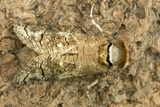Cossus cossus (Linnaeus, 1758) Species
Last modified: Oct. 2, 2025, 12:59 p.m.
A common species throughout Belgium. Most records are from the northern part of the country.
This species is considered Least Concern according to the IUCN Red List category for Flanders 2023.
Details
- Classification
- Family: Cossidae > Subfamily: Cossinae > Genus: Cossus > Species: Cossus cossus
- Vernacular names
- Wilgenhoutrups (NL), Goat Moth (EN), Cossus gâte-bois (FR), Weidenbohrer (DE)
- Synonyms
- Cossus ligniperda (Fabricius, 1794)
- First mention in Belgium
- De Sélys-Longchamps E. 1837. Catalogue des Lépidoptères ou Papillons de la Belgique, précédé du tableau des Libellulines de ce pays. — — : 1–29. On page 24 (as Cossus Ligniperda). view page
- Status
-
Native
Distribution
Egg
The eggs are pale brown and oblong and are deposited in clusters in bark crevices, often near old holes of caterpillars or other damage.
Bionomics
The caterpillar develops under the bark and deeper in the wood of at least partially living deciduous trees, especially in willows and poplars. It hibernates two to four/five times, sometimes the last hibernation takes place in a cocoon. The caterpillar holes are located low in the trunk and can be recognized by the presence of wood powder and the sour smell (vinigar) that the caterpillars secrete. They usually leave their tree and create a cocoon in the soil in some distance.
The adult moths come to light.
Flight periods
The adults fly usually in one generation a year, mainly from early June towards late August, with a peak during June. Some individuals are sometimes seen as early as late April, some till late September.
Observed on
- Substrates:
- Deciduous trees
The polyphagous larva feeds on the wood of various deciduous trees like Salix, Betula, Populus, Alnus, Juglans regia, Quercus robur, Fagus sylvatica, Castanea sativa, Pyrus communis, Malus domestica, Prunus, Cydonia oblonga, Fraxinus excelsior, Olea europaea, Ulmus glabra, Tilia, Acer platanoides, Aesculus, Platanus, Morus, Hippophae rhamnoides, Vitis, Lonicera xylosteum, Lonicera etc...Also reported on Larix, but this exceptional.
Host plants are known from more than 20 different plant families.
Habitat
It prefers a moist environment like river banks, swamps, forest edges, riparian woodland, scrub, gardens, grasslands etc...








